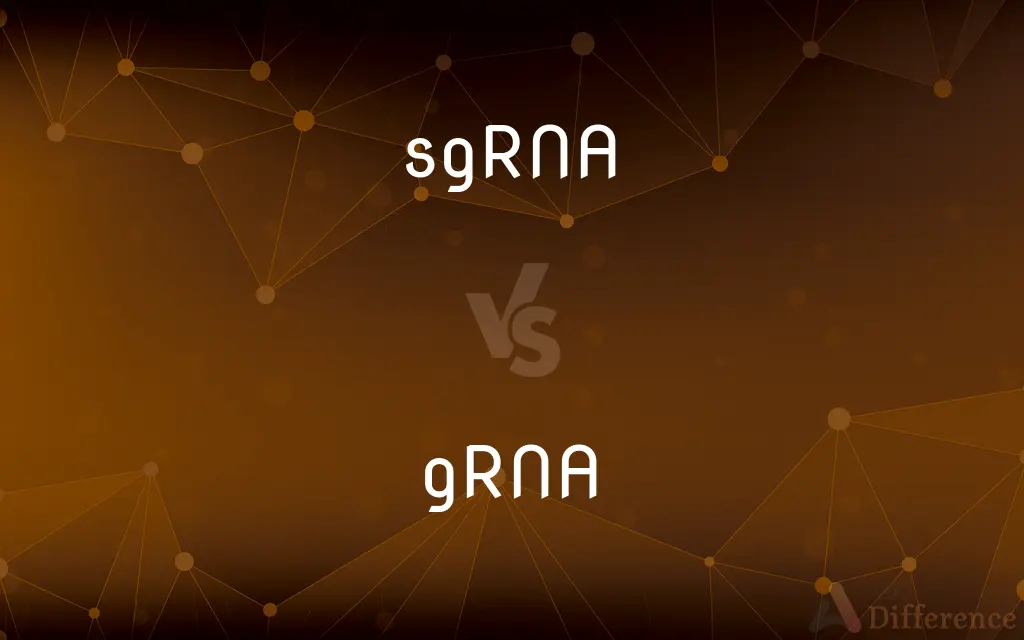sgRNA vs. gRNA — What's the Difference?
By Tayyaba Rehman — Published on December 11, 2023
sgRNA (single-guide RNA) is a fusion of crRNA and tracrRNA used in the CRISPR-Cas9 system, while gRNA (guide RNA) is a general term referring to RNAs that guide the binding of proteins.

Difference Between sgRNA and gRNA
Table of Contents
ADVERTISEMENT
Key Differences
sgRNA and gRNA are pivotal components in the realm of genetic engineering. sgRNA, which stands for single-guide RNA, is specifically tailored for the CRISPR-Cas9 genome-editing system. On the other hand, gRNA, or guide RNA, is a broader term that pertains to any RNA molecule guiding protein binding.
In the context of the revolutionary CRISPR-Cas9 system, sgRNA is a fusion of two RNAs: crRNA and tracrRNA. This fusion is integral for the precise targeting and editing of genomes. Conversely, while gRNA can be used in CRISPR systems, the term doesn't exclusively apply to this domain and can be seen in other biological contexts.
The design and functionality of sgRNA make it a crucial player in CRISPR-Cas9, guiding the Cas9 protein to the exact DNA location that needs editing. gRNA, in its general sense, can guide various proteins to RNA or DNA targets, depending on its specific function and the system it's utilized in.
The creation of sgRNA was a breakthrough in simplifying the CRISPR system. By merging crRNA and tracrRNA, researchers streamlined the genome-editing process. gRNA, being a more general term, encompasses a broader range of functions, and its specifics vary based on the system or process it's a part of.
Both sgRNA and gRNA hold paramount importance in modern biology. While sgRNA's role is more defined within the CRISPR-Cas9 framework, gRNA serves as an umbrella term, representing the various RNAs guiding protein interactions.
ADVERTISEMENT
Comparison Chart
Full Form
Single-guide RNA
Guide RNA
Specificity
Specifically for CRISPR-Cas9
General term for RNAs guiding protein binding
Composition
Fusion of crRNA and tracrRNA
Varies based on context
Main Function
Guides Cas9 protein in CRISPR-Cas9 system
Guides proteins to RNA or DNA targets
Associated Systems
Primarily CRISPR-Cas9
Various systems including but not limited to CRISPR
Compare with Definitions
sgRNA
A fusion RNA molecule used in the CRISPR-Cas9 system.
Scientists utilize sgRNA to target specific DNA sequences in the CRISPR-Cas9 framework.
gRNA
Essential for accuracy in certain molecular interactions.
Systems that employ gRNA benefit from its precise guiding capabilities.
sgRNA
Tailored for precise genomic interventions.
With sgRNA's guidance, researchers can make exact modifications at desired genomic locations.
gRNA
A general term for RNAs guiding protein interactions.
Many processes rely on gRNA to dictate specific protein-RNA or protein-DNA engagements.
sgRNA
A streamlined tool for genome editing using CRISPR-Cas9.
The introduction of sgRNA greatly enhanced the efficiency of CRISPR-Cas9 editing.
gRNA
Not exclusive to the CRISPR domain.
Though gRNA is often associated with CRISPR, it exists and functions in other contexts as well.
sgRNA
Comprises both crRNA and tracrRNA.
The innovative design of sgRNA, merging crRNA and tracrRNA, simplified genome editing.
gRNA
An RNA molecule that guides protein binding.
In various biological systems, gRNA plays a role in ensuring proteins bind to the right targets.
sgRNA
Directs the Cas9 protein to DNA targets.
In CRISPR experiments, sgRNA ensures the Cas9 protein reaches its intended DNA destination.
gRNA
Can be seen in multiple biological processes.
Researchers often study gRNA in various settings to understand its diverse roles.
sgRNA
Alternative form of sgRNA
gRNA
Alternative form of gRNA
Common Curiosities
What does sgRNA stand for?
sgRNA stands for single-guide RNA.
Is gRNA specific to the CRISPR-Cas9 system?
No, gRNA is a general term and is not exclusive to the CRISPR-Cas9 system.
Why was sgRNA introduced in the CRISPR-Cas9 system?
sgRNA streamlined the process by combining the functions of crRNA and tracrRNA.
What are the main components of sgRNA?
sgRNA is composed of crRNA and tracrRNA.
How long are typical sgRNA and gRNA sequences?
Length varies, but sgRNA for CRISPR-Cas9 is typically around 100 nucleotides, while gRNA length depends on its specific function and context.
Can gRNA guide protein to DNA targets?
Yes, gRNA can guide proteins to both RNA and DNA targets, depending on its function.
Does sgRNA only work with the Cas9 protein?
While sgRNA is primarily associated with Cas9, variations might guide other proteins in modified systems.
Is the specificity of sgRNA important for genome editing?
Absolutely, sgRNA's specificity ensures precise editing at the desired DNA location.
What makes sgRNA distinct in the CRISPR-Cas9 system?
sgRNA is a fusion of crRNA and tracrRNA, specifically tailored for guiding Cas9 in CRISPR-Cas9.
Are there other systems apart from CRISPR that use gRNA?
Yes, gRNA is used in various biological systems outside of CRISPR.
Do both sgRNA and gRNA have therapeutic potential?
Yes, both sgRNA and gRNA are being explored for therapeutic applications in genetic engineering.
How does gRNA determine where a protein should bind?
gRNA has specific sequences that match target RNA or DNA, ensuring accurate protein binding.
Can gRNA guide protein-RNA interactions?
Yes, gRNA can guide proteins to specific RNA targets based on its sequence.
Are sgRNA and gRNA naturally occurring or lab-made?
Both can be naturally occurring, but for research and therapeutic purposes, they are often synthesized in labs.
How are sgRNA and gRNA synthesized?
Both can be synthesized in labs using specific templates and RNA synthesis techniques.
Share Your Discovery

Previous Comparison
Nuts vs. Bolts
Next Comparison
Carry vs. ConveyAuthor Spotlight
Written by
Tayyaba RehmanTayyaba Rehman is a distinguished writer, currently serving as a primary contributor to askdifference.com. As a researcher in semantics and etymology, Tayyaba's passion for the complexity of languages and their distinctions has found a perfect home on the platform. Tayyaba delves into the intricacies of language, distinguishing between commonly confused words and phrases, thereby providing clarity for readers worldwide.
















































